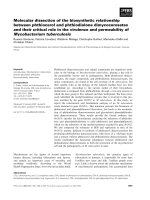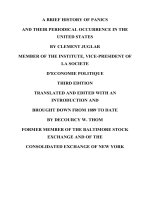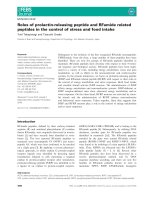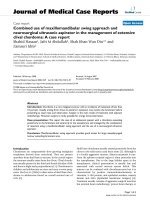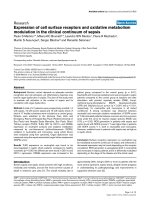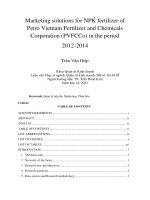Genetic character of Tacca chantrieri André and their phylogenetic inference in the genus Tacca based on its rDNA sequences analysis
Bạn đang xem bản rút gọn của tài liệu. Xem và tải ngay bản đầy đủ của tài liệu tại đây (337.62 KB, 8 trang )
Biotechnology and Seedling
GENETIC CHARACTER OF Tacca chantrieri André AND THEIR
PHYLOGENETIC INFERENCE IN THE GENUS Tacca BASED
ON ITS-rDNA SEQUENCES ANALYSIS
Vu Dinh Giap1*, Pham Mai Phuong2, Bui Thi Tuyet Xuan3, Bui Van Thang4,
Trinh Thi Thuy Linh4, Vu Kim Dung4, Vu Dinh Duy2*
1
HaUI Institute of Technology, Hanoi University of Industry
2
Vietnam - Russia Tropical Centre
Institute of Ecology and Biological Resource, Vietnam Academy of Science and Technology
4
Vietnam National University of Forestry
3
SUMMARY
Tacca J.R. & G. Forst is the only genus in Taccaceae includes 17 species distributed on the world, of which have
found 7 species in Vietnam. DNA barcoding is a method of rapid species identification and discovery using short,
standardized genes or DNA regions. In this study, we have sequences nuclear gene region (ITS-rDNA) from 9
individuals of Tacca chantrieri André belonging to three natural populations (Song Hinh Nature Reserve, Phu
Yen Province; Cuc Phuong National Park, Ninh Binh province and Ba Vi National Park, Ha Noi city) to
investigate genetic character and their phylogenetic inference in the genus Tacca. DNA was extracted from the
tissue of leaves. The nucleotide sequence of ITS-rDNA was determined to be 674bp. All samples collected at three
different geographic locations for the ITS-rDNA gene regions showed that their length and nucleotide sequence
similarity were 100%. The analysis indicated the mean base compositions were nucleotide T(U) (16.9%), C
(29.5%), A (20.3%) and G (33.2%). The TA content was found to be low (37.2%), compared to 62.8% of the CG
content. Phylogenetic analyses using maximum likelihood (ML) indicated that all samples from Vietnam have a
close relationship with Tacca chantrieri in GenBank with strong supporting values (99%). Genetic p-distances
interspecific divergence within and among Tacca species were varied from 0% to 19%, mean genetic distance
10%. The gene (ITS-rDNA) is used as a barcode in the identification of the Tacca species in Vietnam.
Keywords: DNA barcodes, ITS-rDNA gene, Tacca chantrieri, Phylogenetic tree.
1. INTRODUCTION
Tacca J.R. & G. Forst is the only genus in
Taccaceae, a new family derived from
Dioscoreaceae (Caddick et al., 2002; Ding and
Larsen, 2000; Stevens, 2001; Mabberley, 2017).
According to the World Checklist of
Monocotyledons
( the genus
Tacca includes 17 species (T. ampliplacenta L.
Zhang & Q.J.Li, T. ankaranensis Bard. Vauc.
T. bibracteata Drenth, T. borneensis Ridl, T.
celebica Koord, T. chantrieri André, T.
ebeltajae Drenth, T. integrifolia Ker Gawl., T.
lanceolata Spruce, T. leontopetaloides (L.)
Kuntze, T. maculata Seem., T. palmata Blume,
T. palmatifida Baker, T. parkeri Seem, T.
plantaginea (Hance) Drenth, T. reducta P.C.
Boyce & S. Julia và T. subflabellata P.P. Ling
& C.T. Ting) of which in Vietnam have found
7 species: T. chantrieri, T. integrifolia, T.
palmata, T. leontopetaloides, T. plantaginea,
T. subflabellata and T. khanhhoaensis (Nguyen
Tien Ban et al., 2005; Nguyen Tap et al., 2006;
*Correspondence authors: ;
MOST and VAST, 2007; Vo Van Chi, 2012;
Dang et al., 2018).
Tacca chantrieri André (Taccaceae) is a
widespread species in humid tropical regions
of Southeast Asia (Zhang et al., 2011). It’s a
herbal plant that grows in the humid tropical
forests Vietnam (Nguyen Tap et al., 2006). Its
rhizomes have been used as folk medicine to
treat gastric ulcers, enteritis and hepatitis (Vo
Van Chi, 2012). Phytochemical investigations
of this plant have resulted in the isolation of
diarylheptanoids (Yokosuka et al., 2002),
steroidal saponins (Tinley et al., 2003; Shwe et
al., 2010; Yokosuka et al., 2004) and sterol
saponins (Yokosuka et al., 2005). In addition,
these compounds show cytotoxic activities
(Yokosuka et al., 2002). T. chantrieri
distribution is restricted by overexploitation,
habitat destruction, and habitat fragmentation
(Zhang et al., 2011). Although morphological
characteristics of T. chantrieri have been used
to identify the species, these features are
difficult to distinguish. On the other hand, the
molecular characteristics of this species are
still unknown in Vietnam.
JOURNAL OF FORESTRY SCIENCE AND TECHNOLOGY NO. 12 (2021)
19
Biotechnology and Seedling
The use of DNA barcodes, which are short
gene sequences taken from a standardized
portion of the genome and used to identify
species (Kress et al., 2005). Short DNA
barcode sequences can be used to identify
patterns that aren't fully characterized by
morphology (Vu Dinh Duy et al., 2019, 2020,
2021). Genes coding for 45S ribosomal mRNA
are organized into tandem arrays of up to
several thousand copies and contain 18S, 5.8S,
and 26S rRNA units separated by internal
transcribed spacers ITS1 and ITS2. While the
rRNA units are evolutionary conserved, ITS
shows a high level of interspecific divergence
and has been frequently used in genetic
diversity and phylogenetic studies of many
plant groups (Hřibová et al., 2011). Currently,
different researchers have used some region
genes such as ITS, 18S, matK, psbA-trnH,
rbcL, atpA, rbcL, trnL-F, and trnS-trnG in
buiding of DNA barcode for identification of
Tacca species (Zhang et al., 2006; Zhang et
al., 2011; Zhao and Zhang, 2015; Yeng and
Shen, 2019). In this study, we sequenced
nuclear genomic region nucleotides (ITSrDNA) to identify genetic characteristics of T.
chantrieri and their phylogenetic inference in
the genus Tacca. This study contributes to the
development of a DNA barcode database, as a
foundation for conservation, evolution, and
biological systems.
2. RESEARCH METHODOLOGY
2.1. Collection sampling
In this study, 9 samples (young leaves) of T.
chantrieri were collected and placed in plastic
bags with silica gel in the field, and transferred
to the laboratory of Vietnam - Russia Tropical
Centre, stored at -30oC for DNA extraction
(Table 1).
Table 1. Population descriptions of all sampled populations of T. chantrieri in Vietnam
Sample
Pop.
Latitude
Longitude
Altitude
GenBank
Locality
size
code
(N)
(E)
(m)
code
BV01- Ba Vi National Park, Ha
OL45407103
21o36’48’’ 105o20’40’’
355
BV03 Noi City
OL454073
Cuc Phuong National
OL454074CP01o
o
03
Park,
Ninh
Binh 20 20’31’’ 105 35’51’’
356
OL454076
CP03
province
SH01- Song Hinh, Phu Yen
OL45407703
12°48'48"
109°00'33"
286
SH03 province
OL454079
Figure 1. Adult plant of T. chantrieri species collected in Ba Vi National Park
(Photo: Dr. Vu Dinh Duy)
20
JOURNAL OF FORESTRY SCIENCE AND TECHNOLOGY NO. 12 (2021)
Biotechnology and Seedling
2.2. DNA isolation: Total genomic DNA was
extracted using a plant/fungi DNA isolation kit
(Norgenbiotek, Canada). The total DNA purity
and integrity were tested by the Nanodrop ND2000
spectrophotometer
(NanoDrop
Technologies, DE, USA) and then diluted to a
concentration of 20ng/µl.
2.3. PCR amplification: The ITS-rDNA gene
region was amplified through the following
PCR cycling profile: an initial heating step at
94oC for 3 min; followed by incubating for 40
cycles of 94oC for 1 min, 55oC for 1 min,
respectively, and 72oC for 1 min, and
completed by incubating at 72oC for 10 min.
All PCR reactions were performed in 25 µl
volumes using Gene Amp PCR Systems 9700.
Double-stranded DNA was directly amplified
by symmetric polymerase chain reaction
(PCR) amplification using pairs of primers
ITS5 (5'-GGA AGT AAA AGT CGT AAC
AAG G-3') and ITS4 (5'-TCC TCC GCT TAT
TGA TAT GC-3') (White et al., 1990).
2.4. Sequencing of the ITS-rDNA region:
Sequencing was performed on an Avant 3100
automated DNA sequencer using the Dye
Terminator Cycle sequencing kit (PE Applied
Biosystems). Sequencing of the 9 studied
samples used the primers ITS5 and ITS4.
2.5. Phylogenetic analysis: Chromas Pro 2.1.6
software (Technelysium Pty Ltd., Tewantin,
Australia) was used to edit the sequences.
Sequence alignments were made with Bioedit
v7.0.5.2 (Hall, 1999). We used MEGA 7.0
(Kumar et al., 2016) to analyse our data.
Nucleotide sequence divergences were
calculated using the Kimura two-parameter
(K2P). Phylogenetic trees were performed
using maximum likelihood (ML) on MEGA
7.0 software with 1000 replicates. Mega 7.0
was used to analyze p-distance between Tacca
species.
3. RESULTS AND DISCUSSION
3.1. DNA Extraction and Polymerase Chain
Reaction
In plants, secondary metabolites and
polysaccharides interfere with genomic
isolation procedures and downstream reactions
such as restriction enzyme analysis and gene
amplification (Amani et al., 2011). DNA
isolation represents the basic and probably the
most important step in plant genetics and
biotechnology. Despite the development of
molecular protocols for DNA isolation of plant
species, there are still many drawbacks
depending on sample composition. To
maximize DNA yields and minimize the coextraction of PCR inhibitors, we used the Plant
DNA Isolation Kit for DNA extraction from 9
leaf tissues of T. chantrieri in Vietnam. Results
of DNA electrophoresis on 1% agarose gel
showed that each sample had a single, sharp
and bold bands indicating successful DNA
extraction (Figure 2). The purity of extracted
DNA was excellent, as evident DNA
concentrations A260/A280 ratio ranging from
1.840 to 1.956, which also suggested that the
preparations were sufficiently free of proteins
and polyphenolic/polysaccharide compounds.
The DNA concentration ranged from 700 to
920ng/µl. The extracted DNA was suitable for
PCR amplification of plant barcode genes. For
the PCR reaction, the DNA concentration was
diluted to 20 ng/µl. The primer pair ITS5/ITS4
were successfully cloned for 09 samples at a
primer temperature of 55oC (Figure 3). The
PCR product was approximately 700bp in
length. Electrophoresis on a 1.5% agarose gel
showed high quality PCR product, with only a
single bright band that was qualified for
nucleotide sequencing.
Figure 2. Electrophoresis of total DNA from 9 samples of T. chantrieri using 1% agarose gel
JOURNAL OF FORESTRY SCIENCE AND TECHNOLOGY NO. 12 (2021)
21
Biotechnology and Seedling
Table 2. The quantity and purity of extracted DNA from 9 leaf samples of T. chantrieri
No
Sample
Concentration (ng/µl)
A260nm
A280nm
A260nm/A280nm
1
BV01
700
0.070
0.038
1.842
2
BV02
890
0.089
0.049
1.816
3
BV03
860
0.086
0.046
1.869
4
CP01
840
0.084
0.045
1.866
5
CP02
900
0.090
0.046
1.956
6
CP03
920
0.092
0.050
1.840
7
SH01
900
0.090
0.048
1.875
8
SH02
890
0.089
0.046
1.935
9
SH03
860
0.086
0.047
1.830
Figure 3. PCR products from 9 samples of T. chantrieri were electrophoresed on 1.5% agarose gel
(M: DNA ladder 100bp; 1-9: No. samples)
3.2. Characteristic analysis of ITS-rDNA
sequences
All the studied samples were successfully
amplified for ITS-rDNA gene regions with a
high
sequencing
rate
of
100%.
Chromaspro2.1.6 software was used to display
the results and edit the sequences. After
removing the two ends, we identified that the
remaining size of each sample was 674
nucleotides. These sequences have been
compared with similar sequences on GenBank
using the BLAST tool. Results showed that the
studied species was 100% similar to T.
chantrieri (JN850567). The sequences for the
ITS-rDNA gene region from T. chantrieri in
Vietnam have been deposited in GenBank
(Table 1). Moreover, the results of comparing
nucleotide sequences with each other using
Bioedit software between nine samples
22
collected at three different locations in the ITS–
rDNA gene region showed that their length and
nucleotide sequence similarity were 100%.
Therefore, the following study took only one
representative sample of this species in
Vietnam.
For this study, ITS-rDNA sequences of T.
chantrieri consisted of 674 nucleotide
positions. The mean base compositions were
16.9, 29.5, 20.3 and 33.2% for T (U), C, A and
G, respectively. The TA content was low
(37.2%), compared to 62.8% of the CG
content. This difference showed a low TA
content at all three codon positions. These
values were 27.1%, 47.9% and 36.8% for the
1st, 2nd and 3rd codons, respectively. The
average R rate at the second position was 1.8
times, higher than the rate at the two remaining
codon positions (Table 3).
JOURNAL OF FORESTRY SCIENCE AND TECHNOLOGY NO. 12 (2021)
Biotechnology and Seedling
Table 3. Nucleotide base compositions (%) for the ITS-rDNA sequences of T. chantrieri
Base
Codon
Length
R=Si/Sv
position
(bp)
T(U)
C
A
G
All positions
16.9
29.5
20.3
33.2
674
1.5
Tacca
st
chantrieri
1 positions
16.1
28.1
21.0
34.4
224
1.8
nd
2 positions
17.2
29.1
20.7
33.0
227
1.7
3rd positions
17.5
30.9
19.3
32.3
223
1.1
Note: Transitionsal Pairs (Si); Transversional Pairs (Sv)
species pairs: T. chantrieri/T. maculata (19%),
T. cristata/T. maculata (18%) showed highest
genetic distances, whereas lowest genetic
distances were observed between species pairs:
BV/T. chantrieri (0%), T. leontopetaloides/T.
maculate (0%), T. havilandii/T. cristata (1%),
T. reducta/T. cristata (2%). Our results showed
the highest genetic distances among species in
genus Tacca.
3.3. The genetic distance and phylogenetic
inference in the genus Tacca
The genetic distances and the maximum
likelihood (ML) tree were used to determine
genetic relationships between samples and 14
species of the genus Tacca (Table 4 and Figure
4). The mean genetic distance was 10%
ranging from T. leontopetaloides/T. maculate
(0%) to T. chantrieri/T. maculata (19%). The
Table 4. Different genetic distance among species in genus Tacca based on ITS-rDNA analysis
1. BV
2. T. leontopetaloides
MK144476
3. T. havilandii
MK144500
4. T. cristata
MK144506
5. T. borneensis
MK144485
6. T. integrifolia
MK144478
7. T. maculata
MK144480
8. T. reducta
MK144487
9. T. ampliplacenta
JF978853
10. T. bibracteata
MK144508
11. T. parkeri
JN850573
12. T. palmata
MK144499
13. T. palmatifida
JN850572
14. T. subflabellata
JF978885
15. Tacca chantrieri
JN850567
1
-
2
3
4
5
6
0.19
-
0.07
0.18
-
0.06
0.17
0.01
-
0.06
0.17
0.04
0.02
-
0.04
0.18
0.06
0.05
0.05
-
0.19
0.00
0.19
0.18
0.17
0.18
-
0.06
0.18
0.03
0.02
0.03
0.06
0.18
-
0.05
0.18
0.06
0.05
0.05
0.01
0.18
0.06
-
0.12
0.19
0.13
0.12
0.12
0.11
0.20
0.13
0.12
-
0.13
0.22
0.16
0.15
0.15
0.13
0.22
0.15
0.13
0.15
-
0.11
0.17
0.10
0.09
0.09
0.10
0.17
0.10
0.10
0.12
0.15
-
0.10
0.16
0.10
0.09
0.09
0.08
0.16
0.09
0.08
0.09
0.13
0.06
-
0.03
0.18
0.07
0.06
0.05
0.03
0.18
0.06
0.03
0.12
0.14
0.11
0.10
-
0.00
0.19
0.07
0.06
0.06
0.05
0.19
0.07
0.05
0.12
0.13
0.11
0.10
0.03
The maximum likelihood tree of sequence
divergences (K2P) in the ITS-rDNA region
reflects the above findings. It shows that all 14
species in the genus Tacca were distinctly
7
8
9
10
11
12
13
14
15
-
separated and characterized by a high bootstrap
value and a branch length of 0.05 (Figure 4).
The ML tree showed a clear separation of
samples (BV) into one clade together with
JOURNAL OF FORESTRY SCIENCE AND TECHNOLOGY NO. 12 (2021)
23
Biotechnology and Seedling
Tacca chantrieri (JN850567) with a bootstrap
value of 99%. BV/T. chantrieri had highly
identical ITS sequences. The results showed
that this species pair was determined as one
species.
Figure 4. Phylogenetic relationships among Tacca species based on sequence of nuclear genes (ITS-rDNA)
using Maximum likelihood (ML) tree. Numbers above branches represent bootstrap
Accurate species indentification is essential
for the management and conservation of
species (Trias-Blasi and Vorontsova, 2015).
Species identification based on morphology is
mostly laborious and less accurate. However,
molecular-based methods such as DNA
barcoding have been shown to be rapid and
accurate for specific identification (Kress et
al., 2015; Tahir et al., 2018; Kang et al., 2021).
A previous study by Zhao and Zhang (2011)
recommended four candidate DNA barcoding
regions, three (rbcL, matK, and trnH-psbA)
from the chloroplast genome and one (ITS)
from the nuclear genome, which were
evaluated among 36 accessions representing 6
species of Tacca. The results indicated that
both ITS and the core barcode rbcL+matK
proposed by the Consortium for the Barcode of
Life (CBOL) exhibited the highest resolution
as single and combined data, respectively.
Based on overall performance, matK+rbcL can
be considered a potential barcode for
identifying the species of Tacca, ITS can be
used as a supplementary barcode. DNA
24
barcoding revealed two distinct lineages of T.
integrifolia distributed allopatrically in Tibet
and Malaysia. And these two lineages with
morphological variations may potentially
represent new species. Zhang et al. (2011)
used DNA sequences from one nuclear, one
mitochondrial and three plastid loci (ITS, atpA,
rbcL, trnL-F, and trnH-psbA) to reconstruct
molecular phylogeny in the genus Tacca.
Phylogenetic analysis of 16 Tacca species
utilizing nuclear ITS and plastid matK gene
areas (Yeng and Shen, 2019). Our results agree
with the previous finding, confirm the core
barcode's effectiveness, and suggest using ITSrDNA gene region as DNA barcode sequences
in the genus Tacca in Vietnam.
4. CONCLUSIONS
In the current study, we sequenced nuclear
genomic region nucleotides (ITS-rDNA) to
identify T. chantrieri in Vietnam, constructed
phylogenetic trees of the genus Tacca, and
suggest using ITS-rDNA gene region to
identify Tacca species in Vietnam. The
findings there will be significant in the study of
JOURNAL OF FORESTRY SCIENCE AND TECHNOLOGY NO. 12 (2021)
Biotechnology and Seedling
evolution, systematics, and conservation of the
species.
REFERENCES
1. Amani J., Kazemi R., Abbasi AR., Salmanian
AH. 2011. A simple and rapid leaf genomic DNA
extraction method for polymerase chain reaction
analysis. Iranian Journal of Biotechnology 9(1): 69-71.
2. Caddick LR., Rudall PJ., Wilkin P., Hedderson
TAJ., Chase MW. 2002. Phylogenetics of Dioscoreales
based on combined analyses of morphological and
molecular data. Bot J Linn Soc 138: 123-144.
3. Chromas Pro1.2.1.6 (Technelysium Pty Ltd,
Helensvale, Queensland, Australia).
4. Dang VS., Truong BV., Nguyen TPT., Hoang
NS. 2018. Tacca khanhhoaensis V.S. Dang & Vuong
(Taccaceae), a new species from southern Vietnam.
PhytoKeys 114: 115–122.
5. Ding ZZ., Larsen K. 2000. Taccaceae. Flora
China 24: 274-275.
6. Hall TA. 1999. BioEdit: a user-friendly
biological sequence alignment editor and analysis
program for Windows 95/98/2007/NT. Nucl Acids Symp
Ser 41: 95–98
7. Hřibová E., Čížková J., Christelová P., Taudien
S., Langhe E., Doležel J. 2011. The ITS1-5.8S-ITS2
Sequence Region in the Musaceae: Structure, Diversity
and Use in Molecular Phylogeny. PLoS One 6(3):
e17863.
8. />9. Kang. 2021. Molecular identification of
Aquilaria species with distribution records in China
using DNA barcode technology. Mitochondrial DNA B
Resour 6(4): 1525–1535.
10. Kress WJ., García-Robledo C., Uriarte M.,
Erickson DL. 2015. DNA barcodes for ecology,
evolution, and conservation. Trends in Ecology &
Evolution 30: 25–35.
11. Kress WJ., Wurdack KJ., Zimmer EA., Weigt
LA., Janzen DH. 2005. Use of DNA barcodes to identify
flowering plants. Proceding of National Academy of
Sciences 102: 8369-8374.
12. Kumar S., Stecher G., Tamura K. 2016. MEGA7:
Molecular evolutionary genetics analysis version 7.0 for
bigger datasets. Molecular Biology and Evolution 33:
1870-1874.
13. Mabberley D. 2017. Mabberley's Plant-book: A
Portable Dictionary of Plants, their Classification and
Uses. Cambridge University Press, Cambridge.
14. MOST., VAST. 2007. Vietnam red data book,
Part II. Plants. Natural Science and Technology
Publishing House.
15. Nguyen Tap, Ngo Van Trai, Nguyen Trieu, Do
Huy Bich, Pham Thanh Huyen, Nguyen Quynh Nga,
Minh Minh Khoi, Nguyen Duy Thuan, Bui Xuan
Chuong, Nguyen Quang Hao, Nguyen Ba Hoat, Pham
Duy Hung, Ngo Duc Phuong, Le Thanh Son, Hoang
Van Toan, Phan Van Truong. 2006. Checklist of
medicinal plants in Vietnam. Hanoi Science and
Technology Publishing House.
16. Nguyen Tien Ban, Nguyen Khac Khoi, Vu Xuan
Phuong. 2005. List of plant species in Vietnam - Volume
3. Agricultural publishing house.
17. Shwe HH., Aye M., Sein MM., Htay KT.,
Kreitmeier P., Gertsch J., Reiser O., Heilmann J. 2010.
Cytotoxic steroidal saponins from the rhizomes of Tacca
integrifolia. Chemistry & Biodiversity 7: 610-622.
18. Stevens PF. 2001 onwards. Angiosperm
Phylogeny
Website.
/>19.Tahir A., Hussain F., Ahmed N., Ghorbani A.,
Jamil A. 2018. Assessing universality of DNA
barcoding in geographically isolated selected desert
medicinal species of Fabaceae and Poaceae. PeerJ 6:
e4499.
20. Tinley TL., Randall-Hlubek DA., Leal RM.,
Jackson EM., Cessac JW., Quada JC., Hemscheidt TK.,
Mooberry SL. 2003. Taccalonolides E and A: Plantderived steroids with microtubule-stabilizing activity.
Cancer Research 63: 3211-3220.
21. Trias-Blasi A., Vorontsova M. 2015. Plant
identification is key to conservation. Nature 521: 161161.
22. Vo Van Chi. 2012. The Vietnamese Dictionary of
Medicinal Plants. Medical Publishing House, Hanoi,
485.
23. Vu Dinh Duy, Le Xuan Dac, Nguyen Dang Hoi,
Pham Mai Phuong, Dang Ngoc Huyen, Tran Thi Thanh
Huong, Bui Van Thanh, Nguyen Tam Thanh, Bui Van
Thang, Luu Thi Phuong, Vu Thi Thu Hien, Nguyen
Quoc Khanh. 2021. Application of DNA analysis
approach contributes to the identification of several
plant species in Truong Sa archipelago, Khanh Hoa
province, Vietnam. Journal of Forestry Science and
Technology 11: 3-10.
24. Vu Dinh Duy. 2019. Using ITS nuclear gene
nucleotide sequences for identification species in
Dendrobium. Journal of Tropical Science and
Technology 18(7): 3-12.
25. Vu Dinh Duy, Tran Thi Viet Thanh, Phan Ke
Loc, Nguyen Minh Tam, Nguyen Thi Thanh Huong,
Nguyen Thi Hien, Phan Ke Long. 2020. Using ITSrDNA and matK gene nucleotide sequences for
identification ginseng species in Panax in Phu Xai Lai
Leng, Ky Son, Nghe An. Journal of Biotechnology
18(1): 75-85.
26. White TJ., Bruns T., Lee S., Taylor J. 1990.
Amplification and direct sequencing of fungal ribosomal
RNA genes for phylogenetics. In: PCR Protocols: a
guide to methods and applications. (Innis MA, Gelfand
DH, Sninsky JJ, White TJ, eds). Academic Press, New
York, USA, 315–322.
JOURNAL OF FORESTRY SCIENCE AND TECHNOLOGY NO. 12 (2021)
25
Biotechnology and Seedling
27. Yeng WS., Shen CK. 2019. Phylogeny of Tacca
(Taccaceae) and traits in reproductive structures, with
description of a new Bornean species. Biodiversitas 20
(11): 3096-3118.
28. Yokosuka A., Mimaki Y., Sakagami H., Sashida
Y. 2002. New diarylheptanoids and diarylheptanoid
glucosides from the rhizomes of Tacca chantrieri and
their cytotoxic activity. Journal of Natural Products 65:
283-289.
29. Yokosuka A., Mimaki Y., Sakuma C., Sashida Y.
2005. New glycosides of the campesterol derivative
from the rhizomes of Tacca chantrieri. Steroids 70: 257265.
30. Yokosuka A., Mimaki Y., Sashida Y. 2004.
Taccasterosides A-C, novel C28-sterol oligoglucosides
from the rhizomes of Tacca chantrieri. Chemical and
Pharmaceutical Bulletin 52: 1396-1398.
31. Zhang L., Li HT., Gao LM., Yang JB., Li DZ.,
Cannon CH., Chen J., Li QJ. 2011. Phylogeny and
evolution of bracts and bracteoles in Tacca
(Dioscoreaceae). J Integr Plant Biol 53: 901-911.
32. Zhang L., Li Q., Li D. 2006. Genetic diversity of
Tacca integrifolia (Taccaceae) in the Brahmaputra
valley, Tibet. Biodiversity Science 14 (1): 65-72.
33. Zhao Y., Zhang L. 2015. The phylogeographic
history of the selfpollinated herb Tacca chantrieri
(Dioscoreaceae) in the tropics of mainland Southeast
Asia. Biochem Syst Ecol 58:139–148.
34. Zhao YM., Zhang L. 2011. Using DNA
barcoding in genus Tacca (Dioscoreaceae). Plant
Diversity and Resources 33 (6): 674 – 682 (abstract
English).
ĐẶC ĐIỂM DI TRUYỀN CỦA LOÀI RÂU HÙM (Tacca chantrieri André)
VÀ SUY LUẬN PHÁT SINH LOÀI TRONG CHI RÂU HÙM (Tacca)
TRÊN CƠ SỞ GIẢI TRÌNH TỰ VÙNG GEN NHÂN ITS-rDNA
Vũ Đình Giáp1*, Phạm Mai Phương2, Bùi Thị Tuyết Xuân3, Bùi Văn Thắng4,
Trịnh Thị Thùy Linh4, Vũ Kim Dung4, Vũ Đình Duy2*
1
Viện cơng nghệ HaUI, Trường Đại học Công nghiệp Hà Nội
2
Trung tâm Nhiệt đới Việt – Nga
3
Viện Sinh thái và Tài nguyên Sinh vật, Viện Hàn lâm Khoa học và Công nghệ Việt Nam
4
Trường Đại học Lâm nghiệp
TÓM TẮT
Chi Râu hùm (Tacca) là chi duy nhất trong họ Râu hùm (Taccaceae) bao gồm 17 lồi phân bố trên thế giới,
trong đó 7 lồi được ghi nhận ở Việt Nam. Mã vạch DNA là một phương pháp để xác định và phát hiện loài
nhanh chóng dựa trên các gen hoặc vùng DNA ngắn, được tiêu chuẩn hóa. Trong nghiên cứu này, chúng tơi
giải trình tự nucletide vùng gen nhân (ITS-rDNA) từ 9 cá thể Râu hùm (Tacca chantrieri André) thu tại 3 quần
thể tự nhiên ở Việt Nam (Khu bảo tồn thiên nhiên Sông Hinh, Phú Yên; Vườn quốc gia Cúc Phương, Ninh
Bình và Vườn Quốc gia Ba Vì, TP. Hà Nội) để điều tra đặc điểm di truyền và suy luận phát sinh loài của chúng
trong chi Tacca. DNA tổng số được chiết xuất từ mơ của lá. Trình tự nucleotide của gen ITS-rDNA được xác
định với 674bp. Tất cả các mẫu thu thập tại ba địa điểm khác nhau cho thấy độ tương đồng về chiều dài và trình
tự nucleotide của chúng là 100% dựa trên trình tự vùng gen ITS - rDNA. Phân tích đặc điểm trình tự nucleotide
lồi Râu hùm trong nghiên cứu chỉ ra nucleotide T(U) trung bình (16,9%), C (29,5%), A (20,3%) và G
(33,2%). Hàm lượng nucleotide TA thấp (37,2%) so với GC (62,8%). Phân tích phát sinh loài sử dụng phương
pháp khả năng tối đa (ML) chỉ ra rằng tất cả các mẫu trong nghiên cứu có mối quan hệ chặt chẽ với loài Râu
hùm (T. chantrieri) với giá trị ủng hộ cao (bootstrap = 99%). Khoảng cách di truyền (p) giữa các loài trong chi
Tacca thay đổi khá lớn từ 0% đến 19%, trung bình 10%. Kết quả nghiên cứu này đã chỉ ra vùng gen nhân (ITSrDNA) là một cơng cụ hữu ích, làm mã vạch trong việc xác định nhận dạng loài Tacca ở Việt Nam.
Từ khóa: cây phát sinh lồi, DNA mã vạch, Râu hùm, vùng gen nhân (ITS-rDNA).
Received
Revised
Accepted
26
: 21/10/2021
: 23/11/2021
: 06/12/2021
JOURNAL OF FORESTRY SCIENCE AND TECHNOLOGY NO. 12 (2021)

